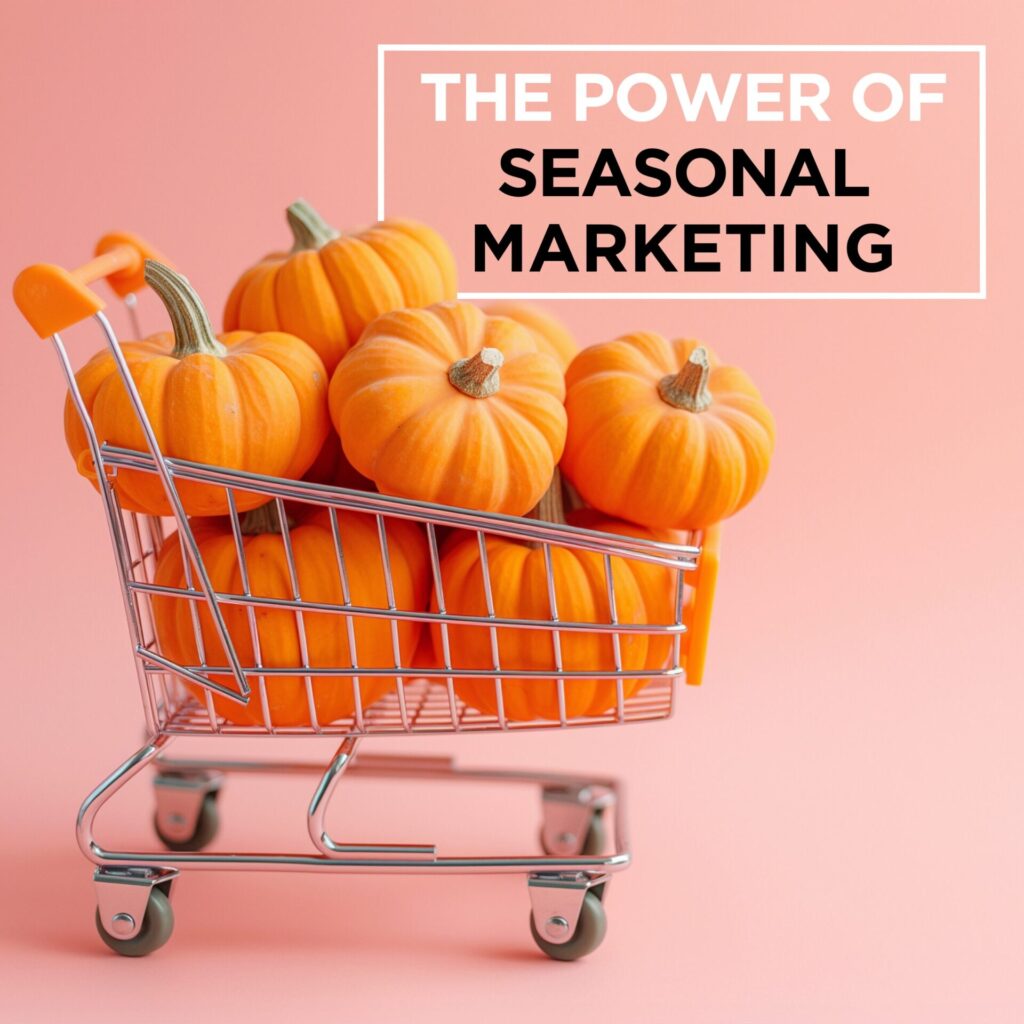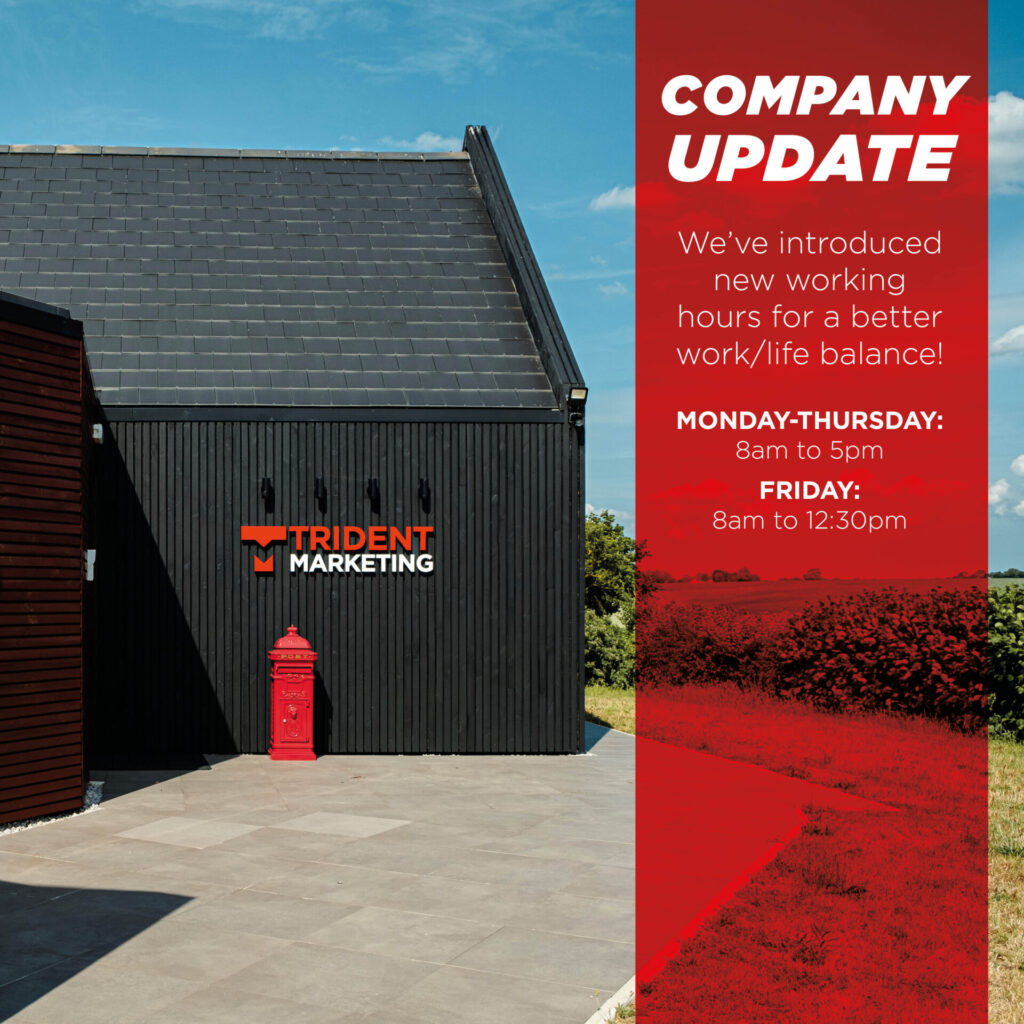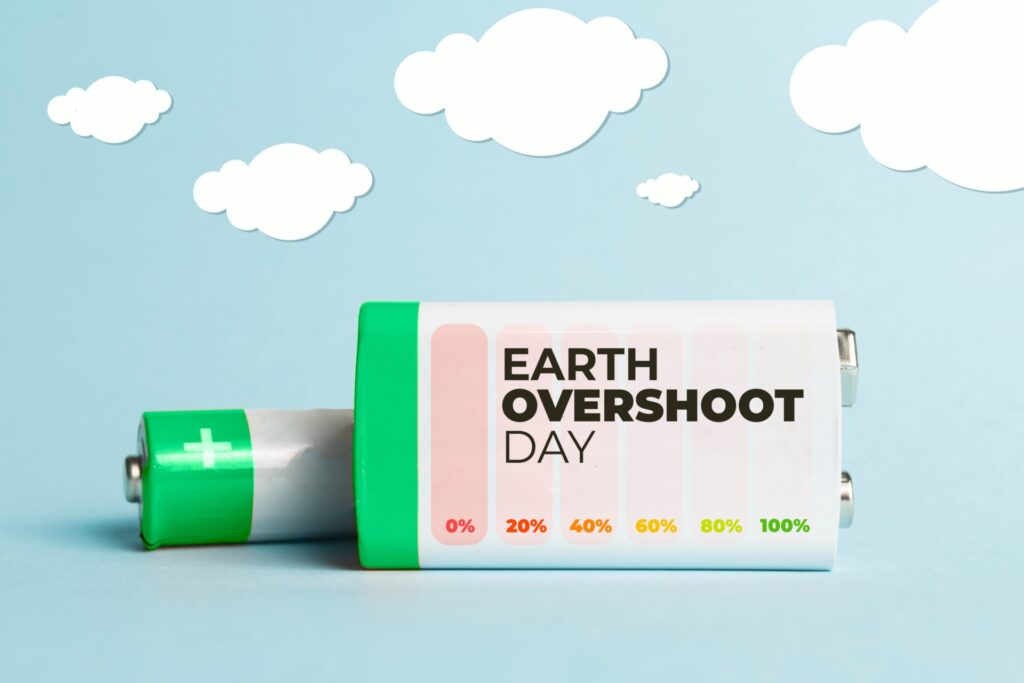The Power of Seasonal Marketing (Especially In October!)

The first day of autumn may fall in September, but October is when we really notice the temperature drop. The shift in seasons also brings a shift in consumer behaviour, making it an ideal time to launch seasonal marketing content that resonates with your audience. Here’s why October is a prime time for your marketing efforts and how you can harness the power of seasonal content to drive engagement and conversions. Consumers Are Ready to Spend As Christmas approaches, consumers start planning their purchases earlier than ever. According to studies, a significant portion of Christmas shopping begins in October – so if you’re in retail or e-commerce, it’s essential that you capture your audience’s attention now. By aligning your content with the season, you can tap into the excitement and anticipation that drives consumer behaviour during this time. Tip: Create seasonal marketing collateral that highlights early-bird deals, gift guides and trends. This can include blog posts, social media campaigns, email newsletters and print marketing. Emotional Connections Are Stronger Autumn is a season rich in emotions – cosying up by the fire, pumpkin spice lattes, family walks and the excitement of Halloween. Leveraging these emotions in your content can help you build a deeper connection with your audience. Seasonal marketing that evokes nostalgia and warmth can be more engaging and memorable, leading to higher brand loyalty. According to Mintel, Halloween spending topped £1bn for the first time in 2023 and consumer spending on Bonfire Night saw an increase of almost 20%. This was driven by a significant uptick in spending from younger generations; 16-34 year-olds were the highest spending age group by far for both occasions. Tip: If your target audience includes 16-34 year-olds, you need to capitalise on their heightened interest in the season. Use storytelling in your content, sharing stories that relate to autumnal traditions, family gatherings or Halloween fun, and tie them back to your brand in a way that feels authentic and relatable. For example, if you’re a housing developer targeting first time buyers, you might consider putting a pumpkin display outside your show home and sharing it on social media. Social Media Engagement Increases It’s natural for social media engagement to dip over the summer months, as people enjoy the weather, go on holiday and ‘switch off’. During autumn and winter, the days are much shorter and colder, so people tend to spend more time indoors; as a result, they also tend to spend more time on social media. Throughout autumn, users share their experiences from Halloween costumes to beautiful orange foliage. This provides an excellent opportunity to create shareable content that aligns with these trends – even if you’re a B2B business. Do you share testimonials? Choose an autumn leaves background. Is your team planning a Halloween bake sale for charity? Share some snaps! Tip: Create a content calendar for October that includes posts themed around key dates like Halloween or World Smile Day (4th October, FYI!) and incorporate hashtags and visuals that are relevant to the season to boost engagement. At Trident Marketing, our digital marketing team would be happy to help. SEO Gets A Steer Seasonal content can also provide significant SEO benefits. Consumers often search for topics and products such as ‘Halloween costume ideas’ and ‘autumn home décor’ during this time. By optimising your content for these seasonal keywords, you can attract more organic traffic to your website. Tip: Conduct keyword research to identify popular seasonal search terms related to your industry. Create blog posts, landing pages and product descriptions that incorporate these keywords to improve your visibility in search engine results. Community & Engagement Is Key Seasonal marketing gives you an opportunity to foster a sense of community amongst your audience. Whether it’s through a Halloween-themed giveaway or an autumn photo competition, encouraging your audience to participate in seasonal activities can enhance engagement and create a stronger connection with your brand. Tip: Encourage your followers to share their favourite autumn recipe, Halloween decorations or autumn adventures, using a branded hashtag. Whatever feels right or appropriate for your business. October is a powerful month for seasonal marketing, offering a unique blend of consumer readiness, emotional appeal and increased social media activity. By strategically incorporating autumnal content into your marketing efforts, you can capture the attention of your audience and drive engagement. Whether through storytelling, SEO optimisation or social media campaigns, the opportunities are vast – so don’t let October pass by without leveraging its full potential for your brand. Are you struggling with how to promote your business alongside the seasons? Get in touch with our team on 01473 823700 or by emailing enquiries@tridentmarketinguk.com.
8 Tips For A Solid Q4 Marketing Strategy: End The Year Strong!

It’s that time of year again, when businesses begin to shift their focus toward the final quarter of the year. This period is crucial for many companies as it includes the holiday season, which can account for a significant portion of annual revenue. Whether you’re in retail, B2B or any other industry, having a solid Q4 marketing strategy is essential to ensure a strong finish to the year. Here we share eight top tips to help businesses prepare for Q4 and make the most of this critical period. 1. Analyse Last Year’s Q4 Performance Before diving into new strategies, it’s essential to review the previous year’s Q4 performance. Analysing what worked and what didn’t will provide valuable insights for planning this year’s campaigns. Look at key metrics such as sales figures, website traffic, customer engagement and conversion rates. Identify any trends, successful campaigns or missed opportunities that can inform your approach this year. 2. Set Clear and Achievable Goals With the insights from last year in hand, set specific, measurable goals as part of your Q4 marketing strategy. These goals should align with your overall business objectives and be broken down into achievable targets, such as increasing sales by a certain percentage, growing your email list or improving customer retention. Setting clear goals will help guide your strategy and ensure that your marketing efforts are focused and effective. 3. Develop a Q4 Content Calendar Content planning is critical year-round, but especially in Q4 with key dates like Halloween, Black Friday and Christmas. Develop a content calendar that outlines these key dates and the content you’ll produce around those times. Plan blog posts, social media content, email campaigns and special offers that resonate with your audience during this period. 4. Optimise Your Website for the Christmas Rush If your business sees a surge in online traffic during Q4, now is the time to ensure your website is optimised for performance. A slow-loading website, complicated checkout process or broken contact form can lead to lost sales. Conduct a thorough audit of your site and ask yourself: Is the content accurate and up-to-date? Is it easy to navigate? Is it mobile-friendly? Is it fast and could it handle increased traffic without slowing down? Is it secure with up-to-date SSL certificates and secure payment gateways? Additionally, consider updating product pages, adding event-specific landing pages and optimising for SEO to capture seasonal search traffic. 5. Leverage Paid Advertising Paid advertising can be particularly effective in driving traffic and sales during Q4. With competition high, it’s important to plan your ad spend strategically. Consider using a mix of Google Ads, social media ads and retargeting campaigns to reach your audience across multiple touchpoints. Focus on high-intent keywords and create compelling ad copy that highlights your Q4 promotions or festive deals. 6. Personalise Your Marketing Efforts Personalisation is key to standing out in a crowded market, especially during the Christmas period. As part of your Q4 marketing strategy, you should consider using customer data to tailor your marketing messages, whether it’s through personalised email campaigns, product recommendations or targeted ads. Segmentation allows you to send more relevant offers to different customer groups, increasing the likelihood of conversion. Personalisation Tactics: Email Segmentation: Send tailored messages based on customer behaviour, preferences and purchase history. Dynamic Content: Use dynamic content on your website or in emails to show personalised product recommendations. Loyalty Schemes: Reward loyal customers with exclusive discounts or early access to sales. 7. Plan for Post-Holiday Engagement Q4 may end on 31st December, but neglecting the post-holiday period in your strategy would be a mistake – it’s a great time to re-engage customers and build momentum for the new year. Plan follow-up campaigns that target customers who made purchases during Q4, offering them incentives to return. Consider launching a New Year’s campaign that promotes new products, services or resolutions for the coming year. New Year Strategies: Thank You Emails: Send personalised thank-you emails to customers who shopped with you during the Christmas season. New Year’s Promotions: Offer discounts or special deals to kick off the new year. Customer Surveys: Gather feedback to improve your products or services for the year ahead. 8. Monitor and Adjust Your Strategy Remember, just because you have a Q4 marketing strategy and a well thought out calendar ahead of time doesn’t mean you have to stick to it religiously – it’ll require regular monitoring and flexibility. Track the performance of your campaigns in real-time and be prepared to make adjustments as needed. If certain ads or content pieces are underperforming, tweak them to improve results. Staying agile also allows you to capitalise on emerging trends or respond to unexpected challenges. Tracking and Analytics: Real-Time Data: Use analytics tools to monitor campaign performance and customer behaviour. A/B Testing: Continuously test different ad creatives, subject lines and offers to optimise results. Feedback Loop: Gather feedback from your team and customers to refine your strategy throughout the quarter. Q4 is a critical period for businesses and preparation is key to making the most of it. By following our 8-step process, you can ensure that your marketing efforts deliver the success your business needs. Would you like Trident Marketing to support your Q4 marketing strategy? Get in touch with our team on 01473 823700 or enquiries@tridentmarketinguk.com.
Building A Green Marketing Strategy: 6 Steps For Small Businesses

As consumers become increasingly conscious of their environmental impact, businesses of all sizes are being urged to adopt more sustainable practices. For small businesses, integrating sustainability into their marketing strategy can be a powerful way to differentiate themselves from competitors, build trust with eco-conscious customers and contribute positively to the planet. But where do you start? This guide will walk you through the essential steps to create a green marketing strategy, tailored for your small business. 1. Understand Your Environmental Impact Before you can market your business as sustainable, it’s crucial to understand your current environmental impact. Conduct an audit of your operations to identify areas where you can reduce waste, lower carbon emissions and use resources more efficiently. Without this type of audit, your green marketing strategy won’t be based on anything substantial. Things to consider: Energy consumption in your office or store The sustainability of your supply chain Waste management and recycling practices The environmental impact of your products or services 2. Set Clear, Achievable Sustainability Goals Once you have a clear understanding of your environmental impact, set specific sustainability goals. These should be realistic and measurable, allowing you to track progress and make adjustments as needed. Don’t forget to set sensible timeframes, to give new schemes and initiatives a chance to embed properly. Examples include: Reducing energy consumption by 20% over the next year Switching to 100% recyclable packaging materials by the next quarter Sourcing 50% of raw materials from certified sustainable suppliers within the next two years 3. Integrate Sustainability Into Your Brand Values For a green marketing strategy to be effective, sustainability must be embedded in your brand’s core values. This means that your commitment to the environment should be evident in every aspect of your business, from the products you sell or services you offer, to the way you interact with customers. Consider: Updating your mission statement to reflect your commitment to sustainability Training employees on sustainable practices and encouraging them to contribute ideas Communicating your environmental values clearly in your marketing materials 4. Partner With Like-Minded Organisations Collaborating with other businesses, not-for-profits or local communities that share your commitment to sustainability can amplify your impact and credibility. Consider: Co-branding Opportunities: Partner with sustainable brands for joint marketing campaigns, product launches or events. Community Involvement: Sponsor local environmental initiatives, participate in litter picking or support eco-friendly charities. This not only boosts your brand’s reputation but also strengthens your connection with the community. Certifications and Affiliations: Seek out certifications like B Corp, Fair Trade or ISO 14001, which can help validate your sustainability claims and enhance your brand’s credibility. 5. Be Transparent and Honest Transparency is key in sustainable marketing. Consumers are increasingly wary of greenwashing – when companies make misleading claims about their environmental efforts. To build trust, be honest about your sustainability journey, including the challenges you face and areas where you’re still working to improve. Publicly Share Your Progress: Regularly update your customers on the progress of your sustainability goals and be open about any setbacks or learnings along the way. Provide Data and Evidence: Whenever possible, back up your claims with data, third-party certifications or testimonials from credible sources. Acknowledge Your Limitations: If there are areas where your business still has room to improve, acknowledge them. Consumers appreciate honesty and will respect your commitment to continuous improvement. 6. Measure and Adjust Your Green Marketing Strategy Sustainability is a continuous journey and it’s important to regularly measure the effectiveness of your green marketing strategy. Use KPIs to track your progress and make data-driven decisions. Monitor Key Metrics: Track metrics such as energy savings, reduction in waste, customer engagement on sustainability-related content, and sales of eco-friendly products. Solicit Feedback: Gather feedback from customers, employees and partners to understand how your sustainability efforts are perceived and where you can improve. Adjust Your Strategy: Based on your findings, adjust your marketing strategy to better align with your sustainability goals and consumer expectations. Building a green marketing strategy as a small business is not just about adopting eco-friendly practices – it’s about integrating sustainability into the very fabric of your brand. By following these steps, you can create a marketing strategy that not only helps the planet but also resonates with your customers and drives business success. Remember, every small step towards sustainability counts, and as your business grows, so will your positive impact on the environment. Find out more about our sustainability journey at Trident Marketing.
Company Update August 2024

Guess what we’ve been trialling? Since March, we’ve worked different hours, finishing at lunchtime on a Friday. Why? For a better work/life balance. The numbers speak for themselves… data from a survey of more than 9,000 UK workers in 2021 showed that employees put work/life balance as their number one priority. And of the organisations that took part in a 6-month UK pilot of a 4-day week in 2022, 89% were still operating the policy a year later. Whilst our business model doesn’t quite suit the traditional 4-day week, we’ve adapted our 37.5 hour working week to allow for an early Friday finish – which has had a really positive effect on all our staff. Equally, there hasn’t been a detrimental effect to our clients and we’re still reachable on Friday afternoons. Take a look at what our MD and staff have to say: Victoria – Managing Director Work/life balance is very important. We really appreciate how hard our staff work, so we started trialling the early finish on a Friday back in March. The feedback from staff has been extremely positive and it hasn’t had a negative impact on production or the service we provide to our valued clients. Elin – Senior Graphic Designer Amending our working hours has meant that we are able to have more of a home/life balance, while still being just as productive in work. Working longer hours during the week and finishing early on a Friday means we are able to make the most of our afternoon and enjoy more of the sun across the summertime. Mackenzie – Digital Marketing Manager It’s nice to finish work at 12:30pm on a Friday because those extra few hours make it feel like a long weekend every week! Getting home earlier means I can do my housework or food shop on a Friday afternoon rather than on the weekend, allowing more time on the weekend to see family and friends. Rosie – Copywriter and Content Manager My partner works a 4-day week, so when our new hours were announced, I was really excited to have a long weekend with him every week. This summer, it’s been especially nice to go home at Friday lunchtime and have lunch in the garden – weather permitting of course! NEW HOURS: Monday-Thursday: 8am to 5pm Friday: 8am to 12:30pm
Ironman 70.3 Bolton 2024

Ironman 70.3 Bolton 2024 Massive congratulations to Victoria and Carl for completing the @ironman_uk 70.3 Bolton! Victoria completed the challenge in 6 hours & 56 minutes, and Carl completed it in 6 hours & 6 minutes! And to their children for doing IRONKIDS the day before – what a family! Especially James who won his heat of the Year 5 IronKids! We’re incredibly proud of their achievement and how hard they’ve worked. They raised a brilliant £2,136 for two local cancer charities: @ukbreastfriends and @sophiestars1.
Earth Overshoot Day 2024: What Does It Mean?

Earth Overshoot Day is a different date each year, and for 2024 it falls on 1st August. That means that from 1st January to 1st August, collectively we have used as much from nature as the planet’s ecosystems can renew during this entire year – that’s according to the latest calculations by Global Footprint Network. So in just seven months, humanity has used what Earth takes 12 months to regenerate. And after today, the remainder of the year corresponds to global overshoot. How Is Earth Overshoot Day calculated? It’s calculated by dividing the planet’s biocapacity (the amount of ecological resources Earth is able to generate that year) by humanity’s Ecological Footprint (humanity’s demand for that year) and multiplying by 365, the number of days in a year. Or if it’s a leap year like 2024, then that would be 366 days. In 1971, Earth Overshoot Day was on 25th December, but since 2005 the date has consistently fallen in August. How Can We Help To #MoveTheDate? The people at the Global Footprint Network naturally want to buck the trend on that graph, with an Earth Overshoot Day that falls later in the year. “Individuals have the power to better their homes and communities. The greatest potential for large-scale impact, however, lies with governments and businesses who align their policies and strategies with the reality of our finite planet,” they explain. “More precisely, immense #PowerOfPossibility can be found in the countless existing solutions that can be implemented at scale. With them, we can make ourselves more resilient and #MoveTheDate of Earth Overshoot Day.” Their Power of Possibility platform highlights many ways we can improve our resource security in five key areas: healthy planet, cities, energy, food and population. Here are some easy-to-digest examples of how we can make change happen: Reforesting 350 million hectares of forest would move the date of Earth Overshoot Day by eight days. Reducing the carbon component of humanity’s Ecological Footprint by 50% would move Earth Overshoot Day by 93 days. Existing off-the-shelf, commercial energy-efficiency technologies for buildings, industrial processes and electricity production could move Earth Overshoot Day by at least 21 days, without any loss in productivity or comfort. If we cut food waste in half worldwide, we would move it by 13 days. How Can We Reduce Food Waste? Did you know that half of the Earth’s biocapacity is used to feed us? And, in the UK alone, we waste approximately 9.5 million tonnes of food every year. Here are some top tips on what you can do to reduce your food waste and become more sustainable: Store food correctly. This will make your food last longer, so check the packaging for instructions or Google if you’re not sure. Your freezer’s your friend. Whether it’s for leftovers, half a loaf of bread or about-to-turn vegetables, your freezer is the perfect way to reduce food waste. Use a compost bin. Pop vegetable waste, egg shells and coffee grounds into your compost bin! Think about the biggest culprits. What do you throw away the most? If it’s fresh herbs, freeze them for future stews or curries. If it’s milk, freeze in ice cube trays. Revive vegetables. Bendy carrots can be good-as-new if you place them in cold water in your fridge. The same works for salad leaves – simply run ice-cold water over them in a colander. Take a measured approach. Always shop with a list so you only buy what you need, and measure foods such as pasta and rice so you don’t overdo it. Find out more about Earth Overshoot Day and consider how you can make a difference.
Electric Car Update

We’ve got a little update for you: our electric car fleet has grown to a family of five! Finance Director Yvette and Project Manager Chris now have electric cars too, taking us another step forward in our sustainability journey. In our drive to becoming fully electric, we’ve already seen a massive difference – spending £15,518.36 less on fuel from October 2022 to September 2023, compared to the year prior. Those figures will be even better for the current period, as our company cars are all electric now – and will be going forward. But… did you know that the electric car movement isn’t all that new? La Jamais Contente, a torpedo-shaped car, was the first ever road vehicle to top 100km/h. It was electric. And the year was 1899! Image credit: Wikimedia Commons Electric Vehicles Of The Past Battery-powered taxis buzzed around London and New York in the 1890s and early 1900s. In fact, there were more than 30,000 electric vehicles registered in the US at a time when the most common form of transportation was still the horse and carriage. Their popularity dwindled due to an absence of power infrastructure beyond big cities, and fuel-powered vehicles soon dominated instead. Why Are Electric Cars Back? So, why have we come full circle? Along with environmental concerns, it’s taken more than a century of battery improvements for electric vehicles to become a viable, appealing alternative to fuel-powered cars. The number of sales has tripled between 2020 and 2022, and although the electric car market accounts for less than 20% of all car sales, the prediction is that they will overtake within the next 15 years. That’s thanks to a number of developments. In 2022, an electric Mercedes travelled over 1,000km through four countries on a single charge. Since then, Toyota and Volkswagen have both announced plans to begin commercial production of next-generation batteries, allowing people to travel roughly double the distance of current petrol or diesel cars without charging. The likes of Ford, General Motors, Jaguar Land Rover and Volvo have set targets of phasing out the production of cars with internal combustion engines entirely by 2040. Engineering firm CALLUM aims to cut charging times to just a few minutes, making the process as convenient as refuelling. Along with Cambridge-based battery developer Nyobolt, the companies have showcased an electric vehicle capable of fully charging in less than six minutes. Mass production is set to begin as soon as this year. The Future Of Electric Cars With these updates, the understandable concerns around reliability and functionality will potentially become a thing of the past. There are still concerns over price (the average cost to buy an electric car in the UK is £50,000) and practicality en masse – such as, how will a row of terraced houses in compact cities charge their cars at home safely? More recently in America, there have been concerns over electric cars’ inability to withstand cold weather – but by cold weather, we mean -35°C. Which is, thankfully, a temperature that’s never been recorded in the UK. One thing’s for sure, we’ll be keeping our ears to the ground for further developments in the electric car market. Let’s all watch this space!
Marketing Trends For 2024: What To Look Out For This Year

Even if you’re not the type of person to make new year resolutions, you can’t help but get that ‘fresh start’ feeling at the start of a new year. Whether it’s in your personal life or when you’ve got your work hat on, you question what you could do differently. Where should I focus my efforts? Should I try something new? Or (if you’re us) what are the marketing trends for 2024? When setting marketing goals for the year ahead, businesses should adopt a forward-thinking approach that aligns with the rapidly evolving landscape of consumer behaviour and technological advancements. Building meaningful connections with your target audience is more important than ever before, but there are numerous ways to do it – and that’s where it can get a little tricky. The most important thing is to analyse what worked well in 2023… and what didn’t. From there, consider the areas you want to focus on. To help, we’ve gathered together some of the biggest marketing trends for 2024, from sustainability to AI-enhanced search. AI Continues To Soar It’ll come as no surprise that AI is first on our list. According to Kantar’s Media Reactions 2023, 67% of marketers feel positive about the possibilities of Generative AI. For 2024, it’ll bring more opportunities for creativity, scale and efficiency. It’s also expanding into more formats, such as audio and video, so expect significant advances in these areas. A recent example is MusicGen, which takes cues from text descriptions or melodies to create music. If Artificial Intelligence baffles you, our very own Jude covered AI basics this time last year. Search Is Changing It is estimated that 6.3 million Google searches happen every minute. According to Kantar, search engines are the fifth strongest touchpoint that delivers on brand impact, compared to 2018 when it was just 11th. Search is becoming so much more than keywords, with more and more people using voice search. Plus, Google launched Search Labs in 2023, which is currently testing SGE (Search Generative Experience) – bringing AI to the forefront. The Power Of Print Marketing As an antithesis to AI, you’ll be pleased to know that print shows up in our marketing trends for 2024. In a world dominated by digital content, having a break from a screen and holding – for example – a luxurious brochure with beautiful imagery offers a tangible experience. With some businesses neglecting print marketing altogether, this could be your opportunity to stand out from the crowd. Short-Form Videos Get Analysed You may want to rethink your Instagram strategy for 2024. Research by customer engagement company Emplifi shows that branded video content on Instagram Reels outperforms the same on other platforms, including TikTok and Facebook. They found that Reels over 90 seconds had double the median number of video views than those on TikTok. Not only that, Instagram Reels outperform the platform’s own Stories feature, with six times the amount of reach. That’s not wholly surprising, but here’s the crux – advertisers posted five times as many Stories as they did Reels in 2023. Yes, it’s quicker (often promoting posts from the grid) but it’d be wise to adopt a Reels-first approach for 2024. Sustainability Matters Unlike before, putting value in sustainability is no longer a choice – it’s pretty much essential. If you don’t state your policy, achievements or goals, you’re not only neglecting responsibility, but you could potentially lose business too. As consumers become more aware of their own purchasing habits and responsibility, consider your business’ environmental impact – and make this information easily accessible on your website. Of all the marketing trends for 2024, this is the one that shouldn’t be about box-ticking – consumers will see right through you if it’s all for show. Influencer Marketing Goes Niche In the early days of influencer marketing, you would reach out to the people with the biggest followings hoping for big results. But there’s a growing trend for collaborating with influencers who have much smaller audiences, because they get higher levels of engagement from a dedicated, loyal fan base. This opens up the opportunity for targeted campaigns, connecting with specific communities who have specific interests. Think of it as having a conversation with a pal, rather than broadcasting to the entire nation. Want To Discuss Marketing Trends For 2024? If you’d like to understand the marketing trends for 2024 and how they’ll affect your strategy, simply get in touch with our team. Call 01473 823700 or email enquiries@tridentmarketinguk.com and we’d be happy to help.
Our Favourite Christmas Adverts 2023

The countdown to Christmas is the most wonderful time of the year – so says Andy Williams and so say us. It’s wonderful for so many reasons. Neighbourhoods glow with twinkly lights, frosty mornings are picture perfect, pigs in blankets become a diet staple, and our TVs get a festive makeover with re-runs of The Vicar of Dibley and a smattering of Christmas adverts. The latter is our focus today, as we choose our top Christmas adverts for 2023. Spoiler alert: John Lewis hasn’t made the cut this year. KFC Christmas Advert This KFC Christmas advert tops the list for its humour. The build-up is sensational, with social media comments from KFC customers begging for turkey at Christmas, set to the iconic operatic sounds of nessun dorma. Our favourite comment? ‘Kfc wen you gonna do turkey at #xmas’. Keeping the grammatically painful, text-speak wording was a hilarious move. The crescendo? We saw you. We heard you. And we ignored you. We’re sticking with chicken. That in itself would be enough to promote KFC, but they have released The Stuffing Stacker burger. Happy days! Tesco Christmas Advert Choosing such an un-Christmassy song is always a bold move for a classic festive advert, but Tesco has pulled it off with How Bizarre by OMC. The theme is: Helping you #BecomeMoreChristmas. It captures what we all do in the supermarket at this time of year. We buy festive treats, then some more festive treats, then realise we only actually went into Tesco for milk. Throw in family get-togethers, Christmas nostalgia and a stroppy-turned-chipper teenager, and you’re most definitely onto a winner. Especially when it is, without a doubt, the advert that we’ve seen the most times this season. Amazon Joy Ride, this year’s Christmas offering from Amazon, is simple yet so effective. In their own words, it’s “a story that proves it’s never too late to embrace your inner child and make new memories with old friends.” Three elderly women watch kids go sledging from afar, with one having the bright idea to purchase a comfortable seat cushion from Amazon. The next thing you know, they’re gliding down the snowy hill themselves, reflecting on their youth and living life to the full. It’s incredibly touching without going overboard. Aldi Taking inspiration from Willy Wonka is a clever move by Aldi, with the recent release of the film Wonka starring Timothée Chalamet. There’s so much to love in this Christmas advert… the innuendos, the narration by Jim Broadbent (a national treasure whose voice manages to make you feel festive), and the return of Kevin the Carrot, who first graced our screens back in 2016. It’s a wonderful example of sticking with what works, but switching up the storyline each year. Bravo Aldi! Boots “Mum, who gives presents to Santa?” – an opening line like this one is bound to lead to a heartwarming advert. What follows is a mad-dash road trip to ‘The North’, with an untimely breakdown, unusual modes of transport, and lots of gift giving along the way. Do they make it? Yes. What does Santa get? Boots own brand flight socks. Why do we like this Christmas advert? The unexpected humorous ending, the music, the regular yet understated product promotions, and the #GiveJoy strapline. There’s no failsafe formula for the perfect Christmas advert; either you capture the nation, or you don’t. But there are a number of tricks that can help to get it right. For us, it’s humour, heart, an easy-to-remember strapline, and music that thoroughly fits the bill, whether festive or not. From everyone at Trident Marketing, we hope you have a very happy Christmas and New Year. Bring on 2024 – you can keep an eye on our blog to see what we get up to next.
A Sustainable Alternative To Black Friday

Now, don’t get us wrong… Black Friday deals can be brilliant. Especially if you’re genuinely in the market for a product – like when your vacuum cleaner breaks and Dyson is offering a £200 saving. Perfect. It can be even more beneficial to businesses, potentially giving you your best profits of the year. But it goes without saying that this major shopping event has a negative impact on the environment. We’re here to explain the impact of Black Friday and offer up some more sustainable options. What Is Black Friday? Black Friday is a major shopping day which started in America in the 1970s and is always the day after Thanksgiving, towards the end of November. Once the Thanksgiving festivities are complete, it’s a chance for retailers to capitalise on the beginning of the Christmas shopping period. In more recent years, the shopping event has gone global. Cyber Monday was introduced in 2005 to become the biggest online shopping event of the year, turning the one-day sale into a whole weekend – or in some cases, a week-long or month-long campaign. Why Is It Called Black Friday? The term has had other meanings, but in the 1980s retailers wanted the derivation clarified. The name Black Friday refers to the fact that retailers traditionally operated at a financial loss for most of the year and made their profit during the holiday season, beginning on the day after Thanksgiving. When this was recorded in the financial records, accounting practices would use red ink to show negative amounts and black ink to show positive amounts. Black Friday, therefore, is the beginning of the period when retailers would no longer be ‘in the red’. Is Black Friday Bad For The Environment? There are some frightening statistics associated with Black Friday. Firstly, online shopping can lead to higher emissions than shopping in stores, which is down to the energy needed to run warehouses and emissions from home delivery. In 2021, UK deliveries from Black Friday sales were estimated to release more than 429,000 metric tons of greenhouse gas emissions. Waste is also another massive factor. Huge discounts and cheap products lure people into buying something they don’t need – in fact, roughly 80% of items bought on Black Friday are thrown away after just a few uses or without being used at all! Products that aren’t thrown away are often returned to the company, but they won’t always be put back on sale, leading to more products in landfill. For this reason – and for the fact that turning a profit isn’t a guarantee with such large savings – some retailers don’t take part in Black Friday at all. In the UK last year, Marks & Spencer, B&M, Next, IKEA, Primark and TK Maxx were some of the big brands who didn’t offer discounts. Is There An Alternative? As a sustainable company, we’re all about Green Friday! This alternative day promotes a focus on responsible shopping by buying from small, local, independent shops or opting for second-hand items. By shopping local, you’re also helping the shops that need your support the most during this cost-of-living crisis. There’s also another angle. There is a Green Friday movement to ignore shopping completely, instead encouraging people to get outside in nature, give to worthwhile causes, create something, meditate, or spend time with friends and family. All that good stuff. What Can Businesses Do On Black Friday? As we said before, if your business sees its biggest takings (and profits) on Black Friday, you’re obviously going to want to take part… who could blame you? Whether you’re a small or large business, there are some things you could consider to make the day more green. Only offer all-in-one deliveries, rather than multiple shipments – or encourage your customers to choose that option. Use as little packaging as possible and make sure any packaging you do use is sustainable. Set up a donation scheme at your physical or online checkout, to environmental charities such as Friends of the Earth, and encourage your customers to do their bit. Whatever you decide is right for you as an individual or your business, we hope you have a successful Black (Green) Friday!
